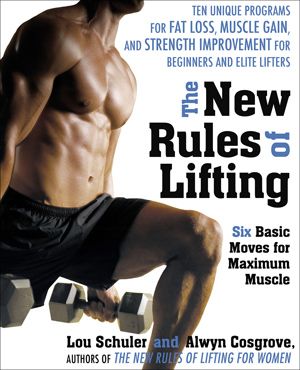First off, most of you as in 99% of you reading this should not be writing your own workouts.
You should either:
- Hire someone knowledgeable
- Go to the Resources page and buy one of the books listed and do the program inside.
But hell lots of “trainers” and “coaches” get “certified” at a weekend seminar and they write programs so it can’t be that hard right?
Well actually it is….and it takes time to get good at it. But even a bad program is still a plan and that’s better than just winging it.
First off, you have to realize the program your on, if your even on one, probably sucks…that’s the first step on the road to recovery.
Here’s how you know you have a crappy program:
- You have no clue what your goal is (keep in mind a goal can be VERY general).
- You have a day of the week for each body part (unless you’re actually a body builder).
- Every time you go to the gym you decide what to do when you get there.
- Every day is a miss mash of random exercises with no basic theme.
If any of these things describes your program…it probably sucks..actually, I know it sucks.
BUTTTT…..BIG BUTTT….at least you’re at the gym, it could be worse.
Now let’s make it better.
How to write a program 101:
Keep in mind this is a very general approach with very basic rules to follow.
Rules:
1. Have a Goal for the Training Cycle and Preferably Each Session:
You have to have a goal, goals can be very general, but you have to know where you’re trying to go.
2. Make Sure your Programming Matches your Goals:
If your goal is to run a faster 5K it’s probably not helpful to be doing a 10×10 high volume squat program while your training for the race.
If you’re trying to get stronger: Heavier weights, limited sets, and adequate rest periods in a session and ample recovery between sessions.
Trying to get leaner: More moderate (but still challenging) weights, shorter rest periods and inadequate recovery in a session.
3. Be Realistic:
If you can’t get to the gym 4 times a week, don’t try a program that’s designed for 4 times a week. You’re going to miss a day, then you’re not doing the program, you’re doing something else.
Write a program that fits your availability.
On that note be realistic when it comes to progress.
If your only getting to the gym 2 times a week don’t expect the progress of the guy who’s here 4 times a week.
and don’t compare yourself to the anomaly of the group who shows up once a week and is jacked….he’s lucky and was blessed with good genetics, you don’t have those, get over it and move on.
4. Prioritize in your Training Week:
If bringing your bench press up is your primary concern you should do your heaviest benching when your freshest which is probably early in your training week.
Putting off training priorities will only allow fatigue to accumulate throughout the week and result in a lesser training effect when you do train those qualities.
5a. Prioritize in Your Training Session:
Here’s the simple rule I use: Can This Kill Me?
If so, do it first
Things like heavy Squats, Deadlifts, Bench Pressing etc take a lot of energy and concentration. It’s easy to get out of the groove, lose technique and get hurt with these lifts….ie, they can kill you…..so do your heaviest sets of them early in the workout.
Wait to the middle/ end portion of the workout to move your heaviest weights and you’re courting disaster.
If you’re using them later in the workout as accessory lifts, that’s fine, just adjust the weights and reps accordingly.
5b. Core Lifts:
Have nothing to do with your abs. We’re talking about Squats, Benches, Deadlifts, Pullups, Rows, Lunges, Floorpress, Shoulderpress etc.
Cause they should be the “Core” of your program.
Prioritize these and never let them leave your program. You can cut some of these exercises themselves out for a number of reasons ie. one doesn’t work for you, doesn’t fit your body etc. But good programs tend to rely on these types of lifts and not on biceps curls, triceps kickbacks and leg extensions.
6. Superset Accessory/ Supplemental lifts:
Super-setting non-competing lifts can save lots of time and still deliver the desired training effect, especially when those lifts are accessory or supplemental lifts…Think: the smaller, easier, lighter stuff you do after the heavy stuff.
A good example of non-competing lifts would be to superset an upper body lift with a lower or a push with a pull.
Examples:
1a) Squat
1b) Floor press
or
1a) Pushup
1b) Pullup
There is however one caveat to this rule: If you’re trying to target certain qualities or bring up a certain lift you may want to do dedicated sets of accessory work. Super-setting will have some negative effect on the exercises from accumulated fatigue no matter what you do.
7. Don’t Change Core Exercises Too Frequently:
I know its popular right now to do the “muscle confusion” thing right now (which BTW is a farce).
But it’s not productive. Constantly changing core lifts is like constantly hitting the reset button.
Give the body (nervous system) a chance to learn the lift, and learn to strain through the exercise. This takes time and shouldn’t be rushed. Keep a core lift in a program for a least 4 weeks before switching, 8 to 12 is better.
Accessory lifts can be cycled out every 2-8 weeks.
The more advanced you are the more frequently you should switch lifts.
8. Plan One Minute for Each Set in a Program and One Minute for Rest Between Each Set:
This 2 minute rule seems to work really well for me when writing programs.
Obviously this changes if you’re on a strength program where you’ll need more rest, but generally speaking if you allot 1 minute to every single exercise and a minute to rest you’ll be able to get a good guess of how much time a program will take while you’re writing it.
That way you wont write a 90 minute session when you only have 45 minutes to work with.
This rule stands for all foam rolling, stretching and other warm-up exercises except I exclude the minute for rest.
9. Optimal Recovery is Essential:
“If you can’t recover you can’t improve”
Understand it’s almost always better to undertrain than to overtrain.
The body has a limited amount of adaptive resources, if you constantly overtrain your sucking the well dry. Always leave a little in the tank and give the body a chance to adapt to the stress you just put on it.
If you’re going balls to the wall for weeks on end, 5 times a week but not eating like a horse and sleeping 12 hours a day, you’re going to be wrecked. ie. overtrained…quickly
Make sure your nutrition/ sleep and other recovery methods match your training.
If you’re doing a fat loss program and calories are reduced you’ll probably have to limit the amount of total work, especially if its high intensity work.
If you’re trying to gain strength and not eating enough and only sleeping 5 hours a night, you’re probably not going to be very successful.
In general 2-3 total body sessions or alternating upper/ lower 4 times a week seem to be the most efficient weekly setups.
Personally, I go:
Monday: Upper
Wednesday: Lower
Friday: Upper
Next week
Monday: Lower
Wednesday: Upper
Friday: Lower
Doing more seems to be counterproductive for most people, unless its low intensity “recovery” work. They either miss sessions and or can’t recover from the sessions they are completing.
10. Make the Plan and Stick to it:
If you decide to write out a plan, do yourself a major favor and FOLLOW THE DAMN PLAN.
Don’t have training ADD, stick with it, give it an honest try. We’re talking 3-6 months at the very least…
Constantly changing programs and goals doesn’t allow you to learn what works best for you and more importantly How to Get Where You’re Going.
Training ADD only assures that you’ll never adapt to your training at all. This will slow your progress over the long-term.
Successful training is a multi-year, multi-phased endeavor. If you’re going to invest the time and effort you mind as well learn what works best for you rather than spin your wheels program hopping for years on end.
With all of that in mind it would probably be better to spend $20-30, buy a good book and do that program or find a good coach (ie NOT the Yoda with the weekend certification) and pay him or her a few hundred to assess you, write a program for you, and show you how to do it without jacking yourself up.




